From Wikipedia, the free encyclopedia
| Queen Elizabeth II of Australia | |
|---|---|
| Monarchy | |
| Federal | |
 Coat of arms of Australia |
|
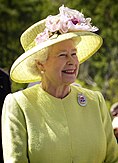 |
|
| Incumbent: Elizabeth II |
|
| Style: | Her Majesty |
| Heir apparent: | Charles, Prince of Wales |
| First monarch: | Queen Victoria |
| Formation: | 1 January 1901 |
The present monarch is Elizabeth II, styled Queen of Australia, who has reigned since 6 February 1952. She is represented in Australia by the governor-general, in accordance with the Australian constitution and Letters Patent from the Queen.[1][2] In each of the states, the monarch is represented by a governor, appointed directly by the Queen on the advice of each of her respective state governments.
The Australian monarch, besides reigning in Australia, separately serves as monarch for each of fifteen other Commonwealth countries known as Commonwealth realms. This developed from the former colonial relationship of these countries to Britain, but they are now independent of each other and are legally distinct.
International and domestic aspects
- Further information: Commonwealth realm: The Crown in the Commonwealth realms
Title
Further information: List of titles and honours of Queen Elizabeth II
The shared and domestic aspects of the Crown are also highlighted in the sovereign's Australian title, currently Elizabeth the Second, by the Grace of God Queen of Australia and Her other Realms and Territories, Head of the Commonwealth.
The sovereign's role specifically as the Australian monarch, as well as
her status as monarch of other nations, is communicated by mentioning
Australia separately from, but along with, the Queen's other lands.
Typically, the sovereign is styled Queen of Australia and is
addressed as such when in Australia or performing duties on behalf of
Australia abroad. The sovereign is the only member of the Royal Family
to have a title established through Australian law; other members are
accorded a courtesy title, which is the title they have been granted via Letters Patent in the United Kingdom.Prior to 1953, the title had simply been the same as that in the United Kingdom, the current form of the title being the result of occasional discussion and an eventual meeting of Commonwealth representatives in London in December 1952, at which Canada's preferred format for the monarch's title was: Elizabeth the Second, by the Grace of God, Queen of [Realm] and of Her other realms and territories, Head of the Commonwealth, Defender of the Faith;[8] however, Australia wished to have the United Kingdom mentioned as well.[9] Thus, the resolution was a title that included the United Kingdom but, for the first time, also mentioned Australia and the other Commonwealth realms, separately. The passage of a new Royal Style and Titles Act by the Parliament of Australia put these recommendations into law. This act was further amended in 1973, removing specific reference to the monarch's role as Queen of the United Kingdom. Still, laws pre-dating the Royal Styles and Titles Acts have not been amended to alter references to the Queen of the United Kingdom.[10]
Finance
Australians do not pay any money to the Queen, either for personal income or to support the royal residences outside of Australia. Only when the Queen is in Australia, or acting abroad as Queen of Australia, does the Australian government support her in the performance of her duties. This rule applies equally to other members of the Royal Family. Usually the Queen's Australian governments pays only for the costs associated with the governor-general and governors in their exercising of the powers of the Crown on behalf of the Queen, including travel, security, residences, offices and ceremonial occasions, etc.Succession
Succession is by primogeniture[11] governed by the provisions of the Act of Settlement 1701, Bill of Rights 1689, and Royal Marriages Act 1772, which limits the succession to the natural (non-adopted), legitimate descendants of Sophia, Electress of Hanover and stipulates that the monarch must be in communion with the Church of England upon ascending the throne. The law still gives preference to sons over any older sisters and stipulates that the monarch cannot be married to a Roman Catholic, but as of 2011 these laws are projected to change.[11] These acts are incorporated into Australian law[12] and lie within the control of the Australian parliament;[13] however, via adopting the Statute of Westminster, Australia agreed not to change its rules of succession without the unanimous consent of the other realms, unless explicitly leaving the shared monarchy relationship; a situation which applies symmetrically in all the other realms and which has been likened to a treaty amongst these countries.[14]
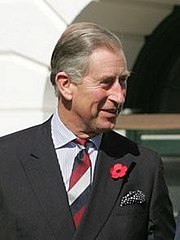 |
| Charles, Prince of Wales, is the heir apparent to succeed Queen Elizabeth II. |
Personification of the state
Further information: The Crown
Today, the sovereign is regarded as the legal personality of the Australian state, and therefore is referred to as Her Majesty The Queen in Right of Australia. For example, if a lawsuit is filed against the Commonwealth government, the respondent is formally described as Her Majesty The Queen in Right of Australia, or simply Regina. Likewise, in a case in which a party sues both the state of Queensland and the federal government, the respondents would formally be called Her Majesty The Queen in Right of Queensland and Her Majesty The Queen in Right of Australia respectively.[citation needed]As such, all state lands are called Crown land, state-owned buildings and equipment are called Crown-held property, and the copyright for all government publications is called Crown copyright. In this role, the monarch is also the locus of oaths of allegiance; many employees of the Crown are required by law to recite this oath before taking their posts, such as all members of the Commonwealth parliament, all members of the state and territorial parliaments, as well as all magistrates, judges, and justices of the peace. This is in reciprocation to the sovereign's Coronation Oath, wherein he or she promises "to govern the Peoples of... Australia... according to their respective laws and customs".[16] Previously, new appointees to Cabinet would also swear an oath that included allegiance to the monarch before taking their post. This oath was never written in law, however, and would only take the form of what the prime minister of the time suggested to the governor-general. In December 2007, Kevin Rudd did not swear allegiance to the sovereign when sworn in by the Governor-General, making him the first prime minister not to do so;[17] however, he (like all other Members of Parliament) did swear allegiance to the Queen, as required by law, when sworn-in by the Governor-General as newly elected parliamentarians. Similarly, the Oath of Citizenship contained a statement of allegiance to the reigning monarch until 1994, when a pledge of allegiance to "Australia" and its values was introduced. The High Court found, in 2002, though, that allegiance to the Queen of Australia was the "fundamental criterion of membership" in the Australian body politic, from a constitutional, rather than statutory, point of view.[6]
Constitutional role
“ |
We have a very good system now in terms of political stability... one of the reasons why we have had this wonderful stability is because of the constitutional linkages from Crown to Governor-General to Prime Minister at the Federal level, and Crown to Governor to Premiers at the State level. There are checks and balances in the system, and that is why we never had civil wars, that is why we never had huge political upheavals except in '32 and '75. So the system as it is has worked very well.[18] |
” |
—Governor-General Michael Jeffery, 2003
|
||
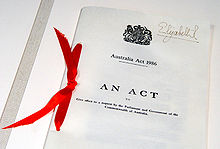
There is some debate over whether the sovereign or the governor-general is Australia's head of state.[20]
Executive
In Australia's constitutional system, one of the main duties of the governor-general is to appoint a prime minister, who thereafter heads the Cabinet and advises the governor-general on how to execute his or her executive powers over all aspects of government operations and foreign affairs. This means that the monarch's and the viceroy's roles are primarily symbolic and cultural, acting as a symbol of the legal authority under which all governments and agencies operate. In practice, ministers direct the use of the royal prerogative, which includes the privilege to declare war, maintain peace, and direct the actions of the Australian Defence Force. The governor-general is empowered by the constitution to summon and prorogue parliament, and call elections; however the powers are almost never exercised without advice from the prime minister. Still, the royal prerogative belongs to the Crown, and not to any of the ministers and the governor-general may unilaterally use these powers in exceptional constitutional crisis situations,[21] such as when, during the 1975 Australian constitutional crisis, Sir John Kerr dismissed Prime Minister Gough Whitlam, on the occasion of a stalemate over government funding between the House of Representatives and the Senate. There are also a few duties which must be specifically performed by the Queen. These include signing the appointment papers of governors-general, the confirmation of the creation of awards of Australian honours,[22][23] and the approval of any change in her Australian title.In accordance with convention, the governor-general, to maintain the stability of government, must appoint as prime minister the individual most likely to maintain the support of the House of Representatives: usually the leader of the political party with a majority in that house, but also when no party or coalition holds a majority (referred to as a minority government situation), or other scenarios in which the governor-general's judgement about the most suitable candidate for prime minister has to be brought into play.[24] The governor-general also appoints to Cabinet the other ministers of the Crown, who are, in turn, accountable to the Parliament, and through it, to the people. The Queen is informed by her viceroy of the acceptance of the resignation of a prime minister and the swearing-in of a new prime minister and other members of the ministry, and she holds audience with her Australian ministers where possible.[25]
Members of various executive agencies and other officials are appointed by the governor-general, including High Court justices. Ministers and parliamentary secretaries are also appointed to the Federal Executive Council (Australia). Public inquiries are also commissioned by the Crown through a Royal Warrant, and are called Royal Commissions. A casual vacancy in the Senate is filled by an appointee from the same political party by a state parliament or state governor.
Foreign affairs
The royal prerogative also extends to foreign affairs: the Governor-General-in-Council negotiates and ratifies treaties, alliances, and international agreements.[26] As with other uses of the royal prerogative, no parliamentary approval is required;[27] however, a treaty cannot alter the domestic laws of Australia; an Act of Parliament is necessary in such cases. The governor-general, on behalf of the Queen, also accredits Australian High Commissioners and ambassadors, and receives diplomats from foreign states. In addition, the issuance of passports falls under the royal prerogative, and, as such, all Australian passports are issued in the name of the governor-general as the monarch's representative.Parliament
The sovereign, along with the Senate and the House of Representatives, being one of the three components of parliament, is called the Queen-in-Parliament. The authority of the Crown therein is embodied in the mace (House of Representatives) and Black Rod (Senate), which both bear a crown at their apex. The monarch and viceroy do not, however, participate in the legislative process save for the granting of Royal Assent by the governor-general. Further, the constitution outlines that the governor-general alone is responsible for summoning, proroguing, and dissolving parliament,[28] after which the writs for a general election are usually dropped by the Prime Minister at Government House. The new parliamentary session is marked by the State Opening of Parliament, during which either the monarch or the governor-general reads the Speech from the Throne. As the monarch and viceroy, by convention, cannot enter the House of Representatives, this, as well as the bestowing of Royal Assent, takes place in the Senate chamber; Members of Parliament are summoned to these ceremonies from the House of Representatives by the Crown's messenger, the Usher of the Black Rod, after he knocks on the doors of the lower house that have been slammed closed on him to symbolise the barring of the monarch from the House of Representatives.All laws in Australia, except in the Australian Capital Territory (ACT) Legislative Assembly, are enacted only with the viceroy's granting of Royal Assent, done by the governor-general or relevant governor, with the Great Seal of Australia or the appropriate state seal, while territorial legislatures, unlike their state counterparts, are subject to the oversight of the government of Australia. The governor-general may reserve a bill "for the Queen's pleasure"; that is withhold his consent to the bill and present it to the sovereign for her personal decision. Under the constitution, the sovereign also has the power to disallow a bill within one year of the Governor-General having granted Royal Assent.[29] This power, however, has never been used.
Courts
In the United Kingdom, the sovereign is deemed the fount of justice.[30][31] However, he or she does not personally rule in judicial cases,[30] meaning that judicial functions are normally performed only in the monarch's name. Criminal offences are legally deemed to be offences against the sovereign and proceedings for indictable offences are brought in the sovereign's name in the form of The Queen [or King] against [Name] (sometimes also referred to as the Crown against [Name]).[32][33] Hence, the common law holds that the sovereign "can do no wrong"; the monarch cannot be prosecuted in his or her own courts for criminal offences. Civil lawsuits against the Crown in its public capacity (that is, lawsuits against the government) are permitted; however, lawsuits against the monarch personally are not cognisable. In international cases, as a sovereign and under established principles of international law, the Queen of Australia is not subject to suit in foreign courts without her express consent. The prerogative of mercy lies with the monarch, and is exercised in the state jurisdictions by the governors,[34] who may pardon offences against the Crown, either before, during, or after a trial.In addition, the monarch also serves as a symbol of the legitimacy of courts of justice, and of their judicial authority; sessions of the High Court, for example, are opened with the words "the High Court of Australia is now in session; God Save the Queen." In a practice dating back to colonial times, state courts traditionally display the arms of the sovereign in right of the United Kingdom, except in New South Wales, where some of these have been replaced with the state arms.
States and territories
Further information: Governors of the Australian states
In accordance with the Australia Act 1986, the Queen has the power to appoint, on the advice of the relevant state premier, a governor in each of the Australian states, who themselves appoint executive bodies, as well as people to fill casual Senate vacancies,
if the relevant state parliament is not in session, under the Great
Seal of the State. The state governors continue to serve as the direct
representatives of the Queen, in no way subordinate to the
governor-general, and they carry out on her behalf all of the Queen's
constitutional and ceremonial duties in respect of their respective
state. The Northern Territory and the Australian Capital Territory resemble states in many respects, but are administered directly by the Commonwealth of Australia; an administrator,
appointed by the governor-general upon the advice of the Commonwealth
government, takes the place of a state governor in the Northern
Territory. The Australian Capital Territory has no equivalent position.Cultural role
Royal presence and duties
Further information: Royal visits to Australia and List of Commonwealth visits made by Queen Elizabeth II
Members of the Royal Family have been present in Australia since the
late 1800s, on military manoeuvres, for official tours, or as the
vice-regal representative of the monarch. Queen Elizabeth II was the
first reigning monarch of Australia to set foot on Australian soil on 3
February 1954. The Queen has visited the country sixteen times, usually
on important milestones, anniversaries, or celebrations of Australian culture,
while other royals have been asked to participate in lesser occasions.
In these instances, when acting at the direction of the Australian Cabinet,
they are doing so as monarch of Australia and members of the Australian
Royal Family, respectively, and will carry out two types of duties: |
| Elizabeth II tours the Australian War Memorial, February 1954 |
Unofficial duties are performed by Royal Family members on behalf of Australian organisations of which they may be patrons, through their attendance at charity events, visiting with members of the Australian Defence Force as Colonel-in-Chief, or marking certain key anniversaries. The invitation and expenses associated with these undertakings are usually borne by the associated organisation.
Apart from Australia, the Queen and other members of the Royal Family regularly perform public duties in the other fifteen nations of the Commonwealth in which the Queen is sovereign. As the Crown within these countries is a legally separate entity from the Australian Crown, it is funded in these countries individually, through the ordinary legislative budgeting process.
Symbols
Main article: Australian Royal Symbols
The monarchy is presently symbolised through images of the sovereign on currency and in portraits in public buildings; on Australian decorations and honours,
some postage stamps and on coats of arms and other government symbols.
The crown is used as a heraldic symbol in the coats of arms of the
Commonwealth and the states of New South Wales, Victoria, Queensland and
Western Australia. Crowns are also visible on police and military
badges. The Queen's Birthday is observed as a public holiday in all states."God Save the Queen" is Australia's royal anthem. The Vice-Regal Salute, played only for the governor-general and each state governor, is the first four and last four bars of "Advance Australia Fair".
There are also hundreds of places named after Australian and British monarchs and members of the Royal Family. The states of Queensland and Victoria were named after Queen Victoria; Adelaide, the capital of South Australia is named after Queen Adelaide, the consort of William IV; numerous streets, squares, parks and buildings are also named in honour of past or present members of the Royal Family.
Religious role
Neither the Queen, the governor-general, or any state governor have any religious role in Australia. There never has been an established church in Australia, either before or since Federation in 1901. Pursuant to the Australian Constitution the Commonwealth may not enact a law establishing or prohibiting the free exercise of religion.[40] This is one of the key differences from the Queen's role in England where she is the Supreme Governor of the Church of England.Vice-regal residences
The Governor-General's official residence is Government House, commonly known as "Yarralumla", in the city of Canberra. The Australian monarch stays there when visiting the country as do some other visiting heads of state.[41] Government House is the site of most state banquets, investitures, swearing-in of ministers, and other ceremonies. Another vice-regal residence is Admiralty House, in Sydney, and is used principally as a retreat for the Governor-General. The states of New South Wales, Victoria, Western Australia, Queensland, Tasmania, and South Australia also maintain residences, used by the respective Governors, though the monarch or other members of the Royal Family will stay there when in the state. These residences are the property of the Crown in respect of each relevant federal or state government, and not of the monarch in his or her personal capacity.Australian Defence Force
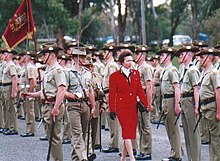 |
| The Princess Royal passes behind the Princess Anne Banner at a parade for the 75th anniversary of the Royal Australian Corps of Signals |
Section 68 of the Australian Constitution says: "The command in chief of the naval and military forces of the Commonwealth is vested in the Governor-General as the Queen's representative." In practice, however, the governor-general does not play any part in the ADF's command structure and the ADF is under the control of the Minister for Defence and several subordinate ministers. The minister advises the governor-general, who acts as advised in the normal form of executive government.[42]
Australian naval vessels bear the prefix Her Majesty's Australian Ship (HMAS) and many regiments carry the "royal" prefix.[43] Members of the Royal Family have presided over military ceremonies, including Trooping the Colours, inspections of the troops, and anniversaries of key battles. When the Queen is in Canberra, she lays a wreath at the Australian War Memorial. In 2003, Elizabeth II acted in her capacity as Australian monarch when she dedicated the Australian War Memorial in Hyde Park, London.[1]
Some members of the Royal Family are Colonels-in-Chief of Australian regiments, including: the Royal Regiment of Australian Artillery; Royal Australian Army Medical Corps; the Royal Australian Armoured Corps and the Royal Australian Corps of Signals, amongst many others. The Queen's husband, the Duke of Edinburgh, is an Admiral of the Fleet[44] in right of the Royal Australian Navy, Marshal of the Royal Australian Air Force, and Field Marshal of the Australian Army.
History
Main article: History of monarchy in Australia
The development of a distinctly Australian monarchy came about
through a complex set of incremental events, beginning with the initial
settlements of the territory in 1770, when Captain James Cook, in the name of, and under instruction from, King George III, claimed the east coast of Australia.[45] Colonies were soon after founded across the continent,[46][47] all of them ruled by the monarch of the United Kingdom, upon the advice of his or her British ministers, the Secretary of State for the Colonies, in particular. After Queen Victoria's granting of Royal Assent to the Commonwealth of Australia Constitution Act on 9 July 1900, which brought about Federation in 1901, whereupon the six colonies became the states of Australia,
the relationship between the state governments and the Crown remained
as it was pre-1901: References in the constitution to "the Queen" meant
the government of the United Kingdom (in the formation of which
Australians had no say)[5] and the Colonial Laws Validity Act 1865 –
by which colonial laws deemed repugnant to imperial (British) law in
force in the colony were rendered void and inoperative – remained in
force at in both the federal and state spheres;[48]
and all the governors, both of the Commonwealth and the states,
remained appointees of the British monarch on the advice of the British
Cabinet,[49] a situation that continued even after Australia was recognised as a Dominion of the British Empire in 1907.[50] As Queen-Empress, Victoria "symbolised the British Empire of which all Australians were subjects".[5] |
| A statue of King George V looks over King's Hall in Old Parliament House, Canberra |
The Curtin Labor Government appointed Prince Henry, Duke of Gloucester, as Governor-General during the Second World War. Curtin hoped the appointment might influence the British to despatch men and equipment to the Pacific War, and the selection of the brother of King George VI reaffirmed the important role of the Crown to the Australian nation at that time.[55] Queen Elizabeth II became the first reigning monarch to visit Australia in 1954, greeted by huge crowds across the nation. Her son Prince Charles attended school in Australia in 1967.[56] Her grandson Prince Harry undertook a portion of his gap-year living and working in Australia in 2003.[57]
The sovereign did not possess a title unique to Australia until the Australian parliament enacted the Royal Styles and Titles Act in 1953, after the accession of Elizabeth II to the throne, and giving her the title of Queen of the United Kingdom, Australia and Her other Realms and Territories. Still, Elizabeth remained both as a queen who reigned in Australia both as Queen of Australia (in the federal jurisdiction) and Queen of the United Kingdom (in each of the states), as a result of the states not wishing to have the Statute of Westminster apply to them, believing that the status quo better protected their sovereign interests against an expansionist federal government, which left the Colonial Laws Validity Act in effect. Thus, the British monarch could still – at least in theory, if not with some difficulty in practice – legislate for the Australian states, and the viceroys in the states were appointed by and represented the sovereign of the United Kingdom, not that of Australia;[58] as late as 1976, the British ministry advised the Queen to reject the nominee of the Queensland Cabinet for Governor.[59] It was with the passage of the Australia Act in 1986, which repealed the Colonial Laws Validity Act, that the final vestiges of the British monarchy in Australia were removed, leaving a distinct Australian monarchy for the nation.
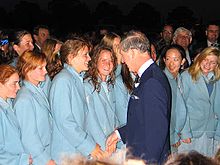 |
| Prince Charles, Prince of Wales, with students of his Australian alma mater, Geelong Grammar School, in Corio, Victoria |
The previous Prime Minister, Julia Gillard re-affirmed her party's platform about a possible future republic. She stated that she would like to see Australia become a republic, with an appropriate time being when there is a change in monarch. A statement unaligned to this position was recorded on 21 October 2011 at a reception in the presence of the Queen at Parliament House in Canberra when Prime Minister Gillard stated that the monarch is "a vital constitutional part of Australian democracy and would only ever be welcomed as a beloved and respected friend."[63] The then Opposition Leader, Tony Abbott, a former head of Australians for Constitutional Monarchy stated on 21 October 2011, "Your Majesty, while 11 prime ministers and no less than 17 opposition leaders have come and gone, for 60 years you have been a presence in our national story and given the vagaries of public life, I'm confident that this will not be the final tally of the politicians that you have outlasted."[64]
A Morgan poll taken in October 2011 found that support for constitutional change was at its lowest for 20 years. Of those surveyed 34% were pro-republic as opposed to 55% pro-monarchist, preferring to maintain the current constitutional arrangements.[65]
List of Australian monarchs
| No. | Portrait | Regnal name | Reign over the Commonwealth of Australia |
Full name | Consort | |
|---|---|---|---|---|---|---|
| 1 |  |
Victoria (1819–1901) House of Hanover |
1 January 1901 | 22 January 1901 | Alexandrina Victoria | none during Australian reign |
| Governors general:John Hope, 7th Earl of Hopetoun Prime ministers: Edmund Barton |
||||||
| 2 |  |
Edward VII (1841–1910) House of Saxe-Coburg and Gotha |
22 January 1901 | 6 May 1910 | Albert Edward | Alexandra of Denmark |
| Governors general:John Hope, 7th Earl of Hopetoun, Hallam Tennyson, 2nd Baron Tennyson, Henry Northcote, 1st Baron Northcote, William Ward, 2nd Earl of Dudley Prime ministers: Sir Edmund Barton, Alfred Deakin, Chris Watson, George Reid, Alfred Deakin, Andrew Fisher, Alfred Deakin |
||||||
| 3 |  |
George V (1865–1936) House of Saxe-Coburg and Gotha (until 1917) House of Windsor (after 1917) |
6 May 1910 | 20 January 1936 | George Frederick Ernest Albert | Mary of Teck |
| Governors general:William Ward, 2nd Earl of Dudley, Thomas Denman, 3rd Baron Denman, Sir Ronald Ferguson, Henry Forster, 1st Baron Forster, John Baird, 1st Baron Stonehaven. Sir Isaac Isaacs Prime ministers: Andrew Fisher, Joseph Cook, Andrew Fisher, Billy Hughes, Stanley Bruce, James Scullin, Joseph Lyons |
||||||
| 4 |  |
Edward VIII (1894–1972) House of Windsor |
20 January 1936 | 11 December 1936 | Edward Albert Christian George Andrew Patrick David | none |
| Governors general: Sir Isaac Alfred Isaacs, Alexander Hore-Ruthven, 1st Earl of Gowrie Prime ministers: Joseph Lyons |
||||||
| 5 |  |
George VI (1895–1952) House of Windsor |
11 December 1936 | 6 February 1952 | Albert Frederick Arthur George | Elizabeth Bowes-Lyon |
| Governors general: Alexander Hore-Ruthven, 1st Earl of Gowrie, Prince Henry, Duke of Gloucester, Sir William McKell Prime ministers: Joseph Lyons, Sir Earle Page, Robert Menzies, Arthur Fadden, John Curtin, Frank Forde, Ben Chifley, Sir Robert Menzies |
||||||
| 6 |  |
Elizabeth II (1926–) House of Windsor |
6 February 1952 | Present | Elizabeth Alexandra Mary | Prince Philip, Duke of Edinburgh |
| Governors general: Sir William McKell, Sir William Slim, William Morrison, 1st Viscount Dunrossil, William Sidney, 1st Viscount De L'Isle, Richard Casey, Baron Casey, Sir Paul Hasluck, Sir John Kerr, Sir Zelman Cowen, Sir Ninian Stephen, William Hayden, Sir William Deane, Peter Hollingworth, Michael Jeffery, Quentin Bryce Prime ministers: Sir Robert Menzies, Harold Holt, John McEwen, John Gorton, William McMahon, Gough Whitlam, Malcolm Fraser, Bob Hawke, Paul Keating, John Howard, Kevin Rudd, Julia Gillard, Kevin Rudd, Tony Abbott | ||||||




No comments:
Post a Comment